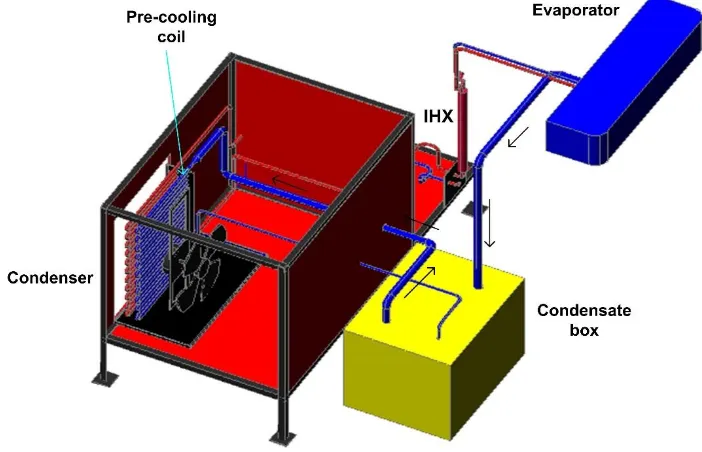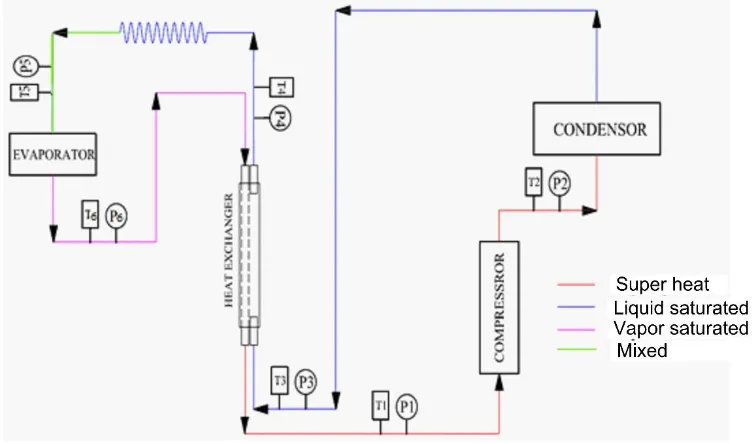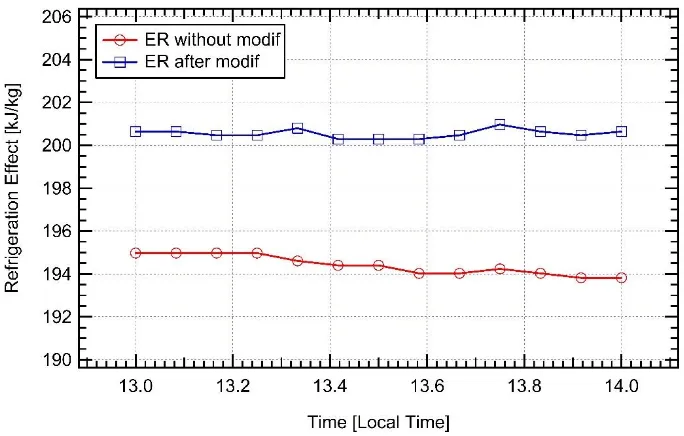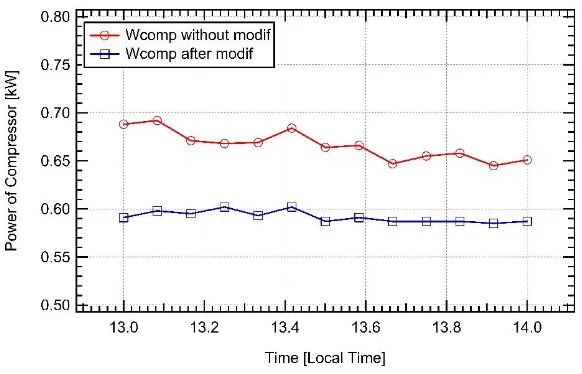IOP Conference Series: Earth and Environmental Science
PAPER
Modification split type air conditioning unit by installing internal heat
exchanger and condenser precooling
To cite this article: H Ambarita 2018 IOP Conf. Ser.: Earth Environ. Sci.126 012018
View the article online for updates and enhancements.
Modification split type air conditioning unit by installing
internal heat exchanger and condenser precooling
H Ambarita
Sustainable Energy and Biomaterial Centre of Excellent, Universitas Sumatera Utara, Jl. Almamater, Kampus USU, Medan 20155, Indonesia
E-mail: [email protected]
Abstract. In this paper, a modified of air conditioning (AC) system is proposed. In the modified system, an internal heat exchanger and condenser precooling unit are installed. The objective is to explore the effect of the additional equipment to the performance of the system. An AC with compressor power of 1 PK is modified and compared with the original one. The results show that ER of the modified system is higher than the original one in order of 3.6%. The work of the compressor of the modified system is 12.5% lower than work of the compressor without modification. Finally, the COP of the modified system is 11.71% higher than the original one. These facts reveal that the combination of IHX and condenser precooling shows positive impact on the performance of the AC. It is recommended to use the modified system to improve the energy efficiency of the Air Conditioning system.
1. Introduction
Housing consumes significant energy due to several reasons such as increasing number of home appliances, quality of life and people spend more time in the house. In a house, the electric energy typically used to power lighting system, air conditioning (AC) unit, entertainment, laundry, etc. In the tropical countries such as Indonesia, air conditioning system consumes significant energy to provide an ergonomic environment. According to a study reported by Batih and Sorapipatana [1], in Indonesia big cities a house typically consumes 20.71% to 32.03% of electricity to power air conditioning unit. Since Indonesia is located in the tropical area, the air conditioning unit is usually used to cool room air. According to Indonesia state owned electricity company (PLN), the residential sector consumed 95.33 TWh in the year 2016. Thus, the air conditioning system in Indonesia consumed electric energy varied from 19.74 TWh to 30.53 TWh. The Government of Indonesia (GoI) is targeting to decrease its energy elasticity by increasing efficiency of all home appliances [2]. Since AC system consumes significant energy, the research on increasing energy efficiency in an AC unit will give significant impact on energy saving program.
In this study, we focus on modification of AC system to increase its energy efficiency by installing an internal heat exchanger and condenser precooling. The internal heat exchanger (IHX) also known as liquid-line/suction-line heat exchanger is a heat exchanger device that uses refrigerant from expansion device to heat refrigerant before entering the compressor. The effect of installing an IHX in a single-stage vapor compression cycle, from a theoretical comparison, can both increase or decrease the efficiency of the system [3]. Several studies on the effect of IHX on the COP can be found in the literature. Aprea et al. [4], assuming adiabatic device and negligible pressure drops, obtained a criterion that has been increasing the COP for several refrigerants such as CFCs, HCFCs, and some substitutes. Domanski et al. [5] and Kim et al. [6] obtained a more elaborated criterion by using
adiabatic IHX and saturating condition at evaporator and condenser outlets are taken into consideration. The same criterion also used by Klein et al. [7] with additional on considering relative refrigerant mass flow rate. Their results show that by neglecting the refrigerant mass flow rate, IHX leads to performance improvements for any refrigerant. Also, IHX has no impact on the condenser power consumption and has an impact on the variation of refrigerant capacity. Mota-Babiloi et al. [8] analyzed the drop-in of an internal heat exchanger in a vapor compression system using R1234ze(E) and R450A as alternatives for R134a. The results show that IHX shows positive influence on the COP due to rising cooling capacity and power consumption remain constant.
The IHX has also tested by Llopis et al. [9] in a low-temperature cycle of a cascade refrigeration plant. The used pair of refrigerant was HFC134a/CO2. The experimental results confirmed that IHX slightly reduces the cooling capacity, but it can increment the overall COP up to 3.7%. Navaro-Esbri et al. [10] experimentally analyzed the influence of IHX on a vapor compression system performance with refrigerant R1234yf as a replacement for R134a. The results showed a reduction in cooling capacity and COP between 6 and 13% had been observed when R134a is replaced by R1234ayf. The present of IHX can help to lessen these reductions between 2 to 6%.
The above studies showed that IHX could provide positive and negative effects to a vapor compression cycle. It depends on the type of refrigerants and testing conditions. In this study, the IHX will be implemented together with condenser precooling to a vapor compression cycle. The effects of both equipment to the performance parameter will be examined. The objective is to explore the effect of both devices to the performance of the system. The results are expected to provide alternative technology that can be used to increase energy efficiency in the air conditioning system. The increasing efficiency of air conditioning system can support the development of a friendly city.
2. Methods
2.1. Experimental apparatus
In this study, a modified vapor compression cycle as an experimental apparatus has been designed and fabricated and shown in Figure 1.
Figure 1. Experimental apparatus.
Friendly City 4 ‘From Research to Implementation For Better Sustainability’ IOP Publishing IOP Conf. Series: Earth and Environmental Science 126(2018) 012018 doi:10.1088/1755-1315/126/1/012018
The apparatus originally used as an air conditioning unit for a room. The experimental apparatus consists of compressor 1 PK, evaporator, condenser, and expansion valve. The commercial name of the AC is Samsung AS09UUQX. The refrigerant of the AC is R22. In the modified system, three equipment is added to the system. They are condensate box, internal heat exchanger, and pre-cooling coil. The condensate from the evaporator will be collected in the box. The condensate will be used to cool the air, and the cooled air will be used to cool the condenser. After cooling the air, the condensate will be sent back to condensate box. The IHX is a heat exchanger where the liquid refrigerant from the expansion valve exchanges the heat with refrigerant before entering the compressor. The exchange heat mechanism makes the vapor quality of the refrigerant entering evaporator decreases. On the other hand, the condition of the refrigerant entering the compressor is above the vapor saturation. The present of the IHX is expected to increase refrigeration effect and decrease compressor work. In the present experiment temperature and pressure of the refrigerant are measured. The evaporator is used to cool a room as a conditioned space.
2.2. Experimental apparatus
The schematic diagram of the process after modified is shown in Figure 2. The figure shows that pressure and temperature of the refrigerant are measured in six points. These measured data will be used to examine the performance.
Figure 2. Diagram process of modified AC system
By using those measured data, the enthalpy of the refrigerant is calculated using table properties of the refrigerant R22. The effect of refrigeration is calculated using the following equation.
6 5
ER h h (1)
Where ER[kJ/kg] is the effect of refrigeration. The parameter h5[kJ/kg] and h6[kJ/kg] are the
enthalpy of the refrigerant at point 5 and point 6, respectively. The compressor power Wc [Watt] input is calculated by using
cos
c
W V I (2)
Where V [Volt] and I [A] are the voltage and the electric current to the compressor. The rate of heat
Where h5[kJ/kg] and h6[kJ/kg] are the enthalpy of the refrigerant at point 5 and point 6, respectively. The Coefficient of Performance is calculated by both cases, ER almost constant during the experiment. It can be seen clearly that ER of the system with IHX (after modification) is higher than ER without modification. This is a positive impact of the IHX to the system. The ER of the system with IHX, in average, is higher 3.16% in comparison with the IOP Conf. Series: Earth and Environmental Science 126(2018) 012018 doi:10.1088/1755-1315/126/1/012018
lower than work of the compressor without modification. This is because of two reasons. The first reason is by installing IHX the condition of the refrigerant is slightly move from saturated to superheat. This will make the difference of enthalpy of the refrigerant out and in is lower than that without modification. The second reason is the cooling coil makes the temperature of the cooling air lower before it enters the condenser. Thus, working temperature and pressure of the condenser will be lower.
Figure 4. The comparison of power of the compressor.
3.3. Coefficient of the performance
Figure 5 shows the Coefficient of the Performance (COP) during the experiment. As a note, the higher COP of a system shows a better efficiency. As expected, the figure shows clearly that the COP of the modified system is better than the original one. This is because the work of compressor is lower and the effect of refrigeration is higher. During the experiment, the COP of the system without modification varies from 3.39 to 3.52. On the other hand, the COP of the modified system varies from 3.70 to 4.01. In average, the COP of the modified system is higher than the system without modification in order of 11.71%.
Figure 5. The comparison of COP.
4. Conclusion
The original vapor compression cycle that is used for AC has been modified and tested. In the modified system, an internal heat exchanger and condenser precooling are installed to the system. The condensate from the evaporator used to cool the cooling air of the condenser. The performance of the modified system and the original one is compared. The results show that ER of the modified system is higher than the original one in order of 3.6%. The work of the compressor of the modified system is 12.5% lower than work of the compressor without modification. Finally, the COP of the modified system is 11.71% higher than the original one. These facts reveal that the combination of IHX and condenser precooling show positive impact on the performance of the AC.
References
[1] Gov. of Indonesia 2017 Presidential Decree No 22 Year 2017 on National Energy Planning [2] Gov. of Indonesia 2011 Presidential Decree No 61 Year 2011 on National Action Plan For
Reducing Greenhouse Gas Emissions
[3] Gosney W B 1982 Principles of Refrigeration (Cambridge University Press) [4] Aprea C, Ascani M and de Rossi F 1999 Applied Thermal Engineering19 329-36
[5] Domanski P A, Didion D A and Doyle J P 1994 International Journal of Refrigeration17 487-93 [6] Kim M H, Domanski P A and Didion D A 1997 NIST Internal report5945
[7] Klein S A, Reindl D T and Brownell K 2000 International Journal of Refrigeration23 588-96 [8] Mota-Babiloni A, Navarro-Esbri J, Barragan-Cervera A, Moles F and Peris B 2015 Energy 90
1636-44
[9] Llopis R, Sanz-Kock C, Cabello R, Sanchez D, Nebot-Andres L and Catalan-Gil J 2016 Applied
Thermal Engineering103 1077-86
[10]Navarro-Esbri J, Moles F and Barragan-Cavera A 2013 Applied Thermal Engineering59 153-61
Friendly City 4 ‘From Research to Implementation For Better Sustainability’ IOP Publishing IOP Conf. Series: Earth and Environmental Science 126(2018) 012018 doi:10.1088/1755-1315/126/1/012018



